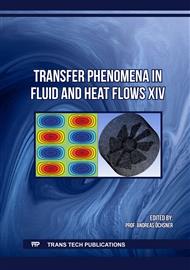[1]
A.F.O. Falcão, J.C.C. Henriques, Oscillating-water-column wave energy converters and air turbines: A review, Renewable Energy 85 (2016) 1391-1424.
DOI: 10.1016/j.renene.2015.07.086
Google Scholar
[2]
Y. Masuda, M.E. McCormick, Experience in pneumatic wave energy conversion in Japan, in: M.E. McCormick, Y.C. Kim (Eds.), Utilization of ocean waves – wave to energy conversion, ASCE, New York, 1987, pp.1-33.
Google Scholar
[3]
H. Schlichting, Boundary-layer theory, McGraw-Hill, New York, 1979.
Google Scholar
[4]
F.H. Harlow, P. Nakayama, Transport of turbulence energy decay rate, Los Alamos Science Lab., University California Report LA-3854 (1968).
Google Scholar
[5]
C.W. Hirt, B.D. Nichols, Volume of fluid VOF method for the dynamics of free boundaries, Journal of Computers and Physics 39 (1) (1981) 201-225.
DOI: 10.1016/0021-9991(81)90145-5
Google Scholar
[6]
FLUENT, User's Guide, ANSYS Inc. (2016).
Google Scholar
[7]
M. Peric, J.H. Ferziger, Computational Methods for Fluid Dynamics, Second ed., Springer, Berlin, 1997.
Google Scholar
[8]
P.Z. Lin, P.L.F. Liu, A numerical study of breaking waves in the surf zone, Journal of Fluid Mechanics 359 (1998) 239-264.
DOI: 10.1017/s002211209700846x
Google Scholar
[9]
A. Elhanafi, A. Fleming, Z. Leong, G. Macfarlane, Effect of RANS-based turbulence models on nonlinear wave generation in a two-phase numerical wave tank, Progress in Computational Fluid Dynamics 17 (3) (2016) 141-158.
DOI: 10.1504/pcfd.2017.084350
Google Scholar
[10]
R.G. Dean, R.A. Dalrymple, Water wave mechanics for engineers and scientists, Advanced Series on Ocean Engineering – Volume 2, World Scientific, 2000.
Google Scholar
[11]
E. Didier, P.R.F. Teixeira, M.G. Neves, A 3D Numerical Wave Tank for Coastal Engineering Studies, Defect and Diffusion Forum 372 (2017) 1-10.
DOI: 10.4028/www.scientific.net/ddf.372.1
Google Scholar
[12]
P.R.F. Teixeira, E. Didier, M.G. Neves, A 3D RANS-VOF wave tank for oscillating water column device studies, in: VII International Conference on Computational Methods in Marine Engineering, Nantes, France, 2017, pp.710-721.
Google Scholar
[13]
A.F.O. Falcão, Control of an oscillating-water-column wave power plant for maximum energy production, Applied Ocean Research 24 (2002) 73-82.
DOI: 10.1016/s0141-1187(02)00021-4
Google Scholar
[14]
R.A.A.C. Gonçalves, P.R.F. Teixeira, E. Didier, F.R. Torres, Numerical analysis of the influence of air compressibility effects on an oscillating water column wave energy converter chamber, Renewable Energy 153 (2020) 1183-1193.
DOI: 10.1016/j.renene.2020.02.080
Google Scholar
[15]
M.R.A. Van Gent, Porous flow through rubble-mound material, Journal of Waterway, Port, Coastal, and Ocean Engineering 121 (3) (1995) 176-181.
DOI: 10.1061/(asce)0733-950x(1995)121:3(176)
Google Scholar
[16]
E. Didier, P.R.F. Teixeira, Validation and Comparisons of Methodologies Implemented in a RANS‐VoF Numerical Model for Applications to Coastal Structures, J. Mar. Sci. Eng. 10 (2022) 1298.
DOI: 10.3390/jmse10091298
Google Scholar
[17]
M.R.A. Van Gent, Stationary and oscillatory flow through coarse porous media, Communications on Hydraulic and Geotechnical Engineering, Report Nº 93-9, Faculty of Civil Engineering, Delft University of Technology (1993).
Google Scholar
[18]
A. Nakayama, F. Kuwahara, A macroscopic turbulence model for flow in a porous medium, Journal of Fluids Engineering 121 (1999) 427-433.
DOI: 10.1115/1.2822227
Google Scholar
[19]
P. Higuera, J.L. Lara, I.J. Losada, Three-dimensional interaction of waves and porous coastal structures using OpenFOAM. Part I: Formulation and validation, Coastal Engineering 83 (2014) 243-258.
DOI: 10.1016/j.coastaleng.2013.08.010
Google Scholar
[20]
E. Didier, J.M. Paixão Conde, P.R.F. Teixeira, Numerical simulation of an oscillation water column wave energy converter with and without damping, in: Fourth International Conference on Computational Methods in Marine Engineering, Lisbon, Portugal, 2011, pp.206-217.
Google Scholar
[21]
P.R.F. Teixeira, D.P. Davyt, E. Didier, R. Ramalhais, Numerical simulation of an oscillating water column device using a code based on Navier Stokes equations, Energy 61 (1) (2013) 513-530.
DOI: 10.1016/j.energy.2013.08.062
Google Scholar
[22]
R.C. Lisboa, P.R.F. Teixeira, F.R. Torres, E. Didier, Numerical evaluation of the power output of an oscillating water column wave energy converter installed in the Southern Brazilian coast, Energy 162 (2018) 1115-1124.
DOI: 10.1016/j.energy.2018.08.079
Google Scholar
[23]
N.G. Jacobsen, D.R. Fuhrman, J. Fredsoe, A wave generation toolbox for the open-source CFD library: OpenFOAM(R), International Journal for Numerical Methods in Fluids 70 (2012) 1073-1088.
DOI: 10.1002/fld.2726
Google Scholar
[24]
B. Devolver, P. Trouch, P. Rauwoens, Performance of a buoyancy-modified k-ω and k-ω SST turbulence model for simulating wave breaking under regular waves using OpenFOAM®, Coastal Engineering 138 (2018) 49-65.
DOI: 10.1016/j.coastaleng.2018.04.011
Google Scholar


